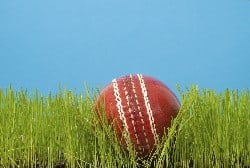
A cricket ball at rest
By Margaret Harris
Late yesterday afternoon, I was pottering around with the BBC’s Test Match Special on in the background when something in the cricket commentary caught my attention. In-between the usual chatter about English bowling (good), Indian batting (bad) and the latest cakes delivered to the TMS commentary box (excellent), the conversation suddenly turned to physics – specifically, to the question of whether a ball could gain speed after nicking the edge of a bat.
The matter was raised after an Indian batsman, V V S Laxman, edged a delivery from Jimmy Anderson, an English bowler. The ball spurted off towards England’s captain, Andrew Strauss, who couldn’t quite catch it. After lamenting the missed opportunity, one of the TMS commentators suggested that Strauss might have mistimed his catch because the ball gained speed after glancing off Laxman’s bat. The commentators then spent the next several minutes talking a load of old rubbish about whether this was physically possible.
Then, shortly after 6 p.m., a secondary-school physics student, Laurence Copson, sent a message to the BBC’s online commentary team claiming that no, it wasn’t possible. “Removing all external forces on the ball, under no circumstance would the ball gain speed after a nick…as [the] bat would be slightly hitting the ball in the opposite direction,” he wrote. However, he did add a caveat: “What may be deceiving is if the batsmen swipes, catches an edge and then the ball gains top-spin and seems to reach the ground quicker than usual.”
This analysis was quickly contradicted by Rob, a university astrophysics student, who pointed out that Copson was neglecting both the elastic coefficients of ball and bat, and (more importantly) “the spin on the ball before it hits the bat which, if very fine, may accelerate the ball…in the direction of spin (like a car with its wheels spinning hitting the ground goes forward)”.
This seemed fair enough, but Rob’s parting shot – ”this is the real world, external forces on the ball can’t be discounted!” – struck me as rather snide, so I decided to do some analysis of my own.
I began by making three assumptions. First, I assumed that Laxman’s bat was completely “dead” when he blocked Anderson’s delivery – in other words, the ball just bounced off the bat, without Laxman introducing additional kinetic energy. I also assumed, initially, that the collision was completely elastic, and that it transferred all of the ball’s “spin” kinetic energy into “linear” kinetic energy. These last two assumptions represent the best-case scenario for converting the ball’s angular momentum into linear momentum – and thereby absolving Strauss of blame.
With the moment of inertia I of a solid ball being 2/5 mr2 , and the rotational kinetic energy 1/2 Iw2 (where w is the angular velocity in radians per second), I get an “inbound” total kinetic energy of 1/2 mv12+ 1/5 mr2w2. This must equal the “outbound” kinetic energy 1/2 mv22 since we’re deliberately ignoring the inelastic nature of the collision and assuming the ball isn’t spinning at all afterwards.
Not being a cricketer myself – I’m American, so I have an excuse – I then hit the Internet to find out the average radius of a cricket ball (3.6 cm), the usual (linear) velocity of balls bowled with spin (around 80 km/hr, or 22 m/s), and their typical rotation rate. There was not much consensus on the latter value, but I took 50 rotations per second (~314 rad/s) as a generous estimate, this being somewhere between the values for golf balls (up to 100 rotations per second) and rugby balls (10ish).
Thus equipped, I solved for the outbound velocity and got 23 m/s. That’s faster than the incoming ball, but not by much – the difference amounts to less than 5%. Throw in the loss of kinetic energy due to heat, sound and deforming the ball and bat, plus the fact that the ball was probably still spinning a bit after it edged Laxman’s bat and headed towards Strauss, and we’re looking at a pretty negligible change. To make matters worse, Anderson isn’t a spin bowler; he’s a paceman, meaning he relies on speed rather than spin-induced unpredictability to trip batsmen up. So that figure of 50 rotations/second is way, way too generous.
In summary, my view is that:
1. Strauss can’t blame his missed catch on physics
2. Copson the school student was wrong on the details but right about the ball not gaining much speed
3. Rob the astrophysics student shouldn’t be so quick to jeer about the “real world”
But if you have other ideas on this particular cricket problem, send us an e-mail to pwld@iop.org. I’d be especially interested in any analysis that does not assume that Laxman was passively blocking the ball, since this is purely a simplifying assumption, not one made to illustrate a best-case scenario.



